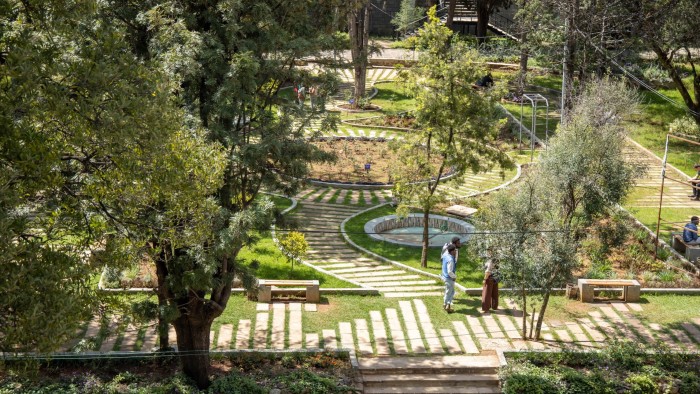Unlock the Editor’s Digest for free
Roula Khalaf, Editor of the FT, selects her favourite stories in this weekly newsletter.
When Michael Harvey and Jen Harbrow heard that the National Trust gardens they cared for in Hampshire were being partnered with a former crown prince’s garden in Ethiopia, they were perplexed. What could their respective Mottisfont and Hinton Ampner sites have in common with the Tsegereda rose garden in Addis Ababa? And “How interested could Africa be in us, what could we share?” wondered Harbrow.
The partnership was part of a two-year pilot scheme, launched in 2023, to address the challenges resulting from climate change. Named Withstanding Change and run by the International National Trusts Organisation (INTO), it was funded with £1.7mn from the British Council’s Cultural Protection Fund. Seven National Trust sites in Wales, Wiltshire, Norfolk and Oxfordshire were paired with heritage bodies in Zanzibar, Uganda, Egypt and Jordan to exchange architectural, horticultural and managerial knowledge.
As the scheme draws to its close in March, a number of remarkable lessons have been learnt that will be applied across the National Trust, says project manager Katherine Shingler. And these have far-reaching relevance for the wider gardening community.

“We have [much] in common in terms of climate and the impact we’re seeing on heritage,” says Shingler. “You can’t deal with these big issues on your own, you have to think internationally and work together to share knowledge and best practice.”
The Mottisfont and Hinton Ampner-Tsegereda exchange was particularly fruitful. Foremost, the Ethiopian gardeners’ expertise in intense heat, extended drought and heavy rainfall proved invaluable for Harvey and Harbrow.
At Mottisfont, home to more than 500 varieties of roses, including a national collection of pre-1900 plants, the walled rose garden retains a lot of heat, says Harvey. “They’re historic roses that flower only once and the flowers go over a lot quicker due to the heat. Roses on the walls suffer dieback because they’re getting so scorched.”

Prolonged heavy rain also water logs the soil and distorts gardening timetables at both Hampshire sites. This is now such an issue at Hinton Ampner that Harbrow often ropes off parts of the garden to visitors due to flooding. “We can’t do the work we’d traditionally do at that time of year, because it’s too wet,” says Harvey. Additionally, pests and diseases such as box blight and whitefly — traditionally a greenhouse pest — are on the rise.
In Ethiopia, Tsegereda garden is part of Addis Ababa university’s campus, but once belonged to then crown prince Asfa Wossen (son of emperor Haile Selassie I). Esther Selassie Antohin, founder and executive director of Heritage Watch Ethiopia, is Wossen’s granddaughter and has led the garden’s restoration under the INTO project. Following the abolition of the monarchy in 1975, the rose garden where she had played as a child had fallen into neglect.
For Antohin, its restoration was crucial for preserving Ethiopia’s heritage for all. “If you don’t know where you came from, I don’t think you’ll have a clear idea where you’re going,” she says. “It’s not idolising the past or saying it was best; it’s that whatever was there has to be known to be rejected or respected.”

She saw the UK as an obvious partner. “In the UK, often there’s no heritage without a garden attached, and Mottisfont and Hinton Ampner showcase how beautifully our past is part of our present.”
Antohin’s team had redesigned Tsegereda from scratch, mitigating the effects of flooding and soil erosion on the sloping site by installing bespoke drainage, creating a rain garden with damp-tolerant plants to absorb excess water, and installing paths with grassy areas between the paving for drainage. However, limited availability of plants, horticultural expertise and commercial knowledge to turn the garden into a self-funding public space restricted its potential.
When Harvey and Harbrow visited Tsegereda, “my main impression was how beautiful it was; green and lush,” says Harbrow. “The water management was cleverly done.” They were struck by how many plants were in both sites, such as lavender, asters, geraniums and hydrangeas. They learnt new mitigating tactics for combating climate change, and how to relay these to a wider audience; a new on-site display in Hampshire demonstrates how flooding is distorting the gardening timetable.

Tsegereda now enjoys access to the National Trust’s expertise and data, including advice from Harvey on the sustainable expansion of the rose garden. Guidance on self-funding will also enable Antohin to open Tsegereda to the public.
The lessons go far beyond roses. Knowledge about how to manage the effects of climate change could help not just historic country houses, but all of us, Shingler says: “People’s homes are going to be affected. I hope that in the longer term this will help other types of sites, not just heritage.”
into.org/withstanding-change-project
Find out about our latest stories first — follow @ft_houseandhome on Instagram


